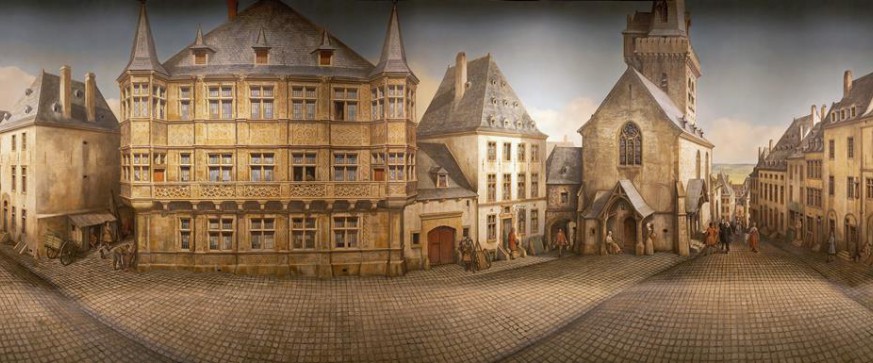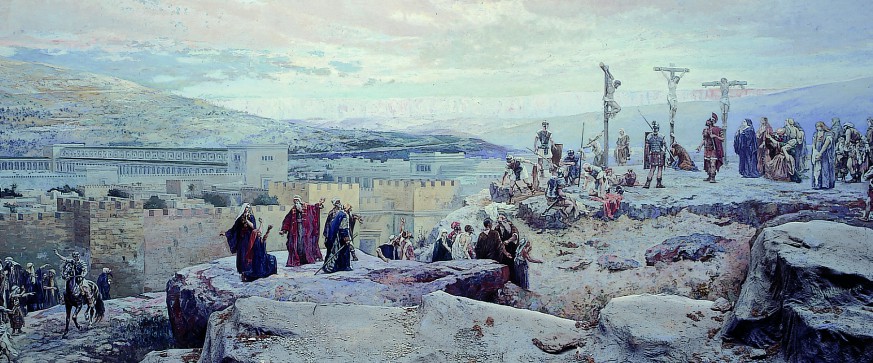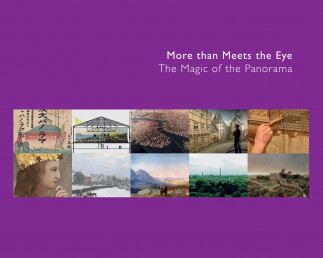New IPC publication launched at the 28th International Panorama Conference in Atlanta, USA, 26-27 September 2019
- Panorama Rouen 1431
created by Yadegar Asisi in 2016
photo © asisi.jpg)
- Panorama Rotunda by Hittdorf
Paris, France in 1838 - Panorama of the Entry of the Magyars / Feszty-Panorama
Opusztaszer, Hungary
© Patrick Deicher - The City of Luxembourg in the 17th century (Artist: Antoine Fontaine)
Musée d'histoire de la Ville de Luxembourg, Luxembourg
© MHVL, Falk Eisleben
- Semi-circle Panorama 'The Berlin Wall' created in 2012 by Yadegar Asisi, © asisi, Tom Schulze
.jpg)
- e-cyclorama by Sanford Wurmfeld
exhibited in Edinburgh, Scotland in 2008.jpg)
- Jerusalem Panorama Crucifixion of Christ, Altötting, Germany, © Stiftung Panorama Altötting / photo H. Heine
.jpg)
- Wilpena Panorama created by Jeffrey B. Morgan, Hawker, Australia
- Diorama of the Conquest of Constantinople in 1453
Military Museum, Istanbul, Turkey
© Patrick Deicher - ICCI 360 Rotunda
seamless 360° film projection in a mobile rotunda
ICCI (Innovation for the Creative and Cultural Industries) with Plymouth University, UK
© Patrick Deicher.jpg)
- Panorama of Jerusalem and the Crucifixion of Christ, Einsiedeln, Switzerland

- Panorama Raclawice
Wroclaw, Poland
© Patrick Deicher
- Panorama of The Battle of Waterloo
Braine l'Alleud, Belgium
© Patrick Deicher.jpg)
- Interactive electronic panorama
exhibited in Luzern, Switzerland in 2010
© Patrick Deicher.jpg)
- Panorama of the City of Salzburg (Sattler-Panorama)
Salzburg, Austria
- Panorama of the Palace and Gardens of Versailles
Metropolitan Museum of Art, New York, USA
© Patrick Deicher
- Panorama of the Chibi War in 208
Wuhan, China
- Panorama of the Battle of Pleven
Pleven, Bulgaria
© Patrick Deicher
- Panorama of the Battle of Ji Nan
Ji Nan, China
- Panorama of the Battle of Mount Isel
TirolPanorama, Innsbruck, Austria
© Patrick Deicher
- Bourbaki Panorama
Luzern, Switzerland
© Emanuel Ammon.jpg)
- News
- More than Meets the Eye – The Magic of the Panorama
More than Meets the Eye – The Magic of the Panorama
Sunday, 10 May 2020Since 1992 the International Panorama Council’s annual conferences are intense encounters bringing together panorama specialists and enthusiasts from all over the world. However, not all conference proceedings have been published. To mark the IPC’s 25th anniversary a new publication with contributions from IPC conferences held over the past years was decided on. More than Meets the Eye – The Magic of the Panorama was successfully launched at the 28th International Panorama Conference at the Atlanta History Center, Atlanta, GA, USA, 26-27 September 2019.
In its wide approach to the panorama phenomenon the publication not only reflects the global community of the International Panorama Council but also contributes to an understanding of the panorama as a truly global art form.
The new publication includes – in six sections – essays by 29 authors who approach the panorama phenomenon from different angles and perspectives, all united by the fascination with the magic of the art form which offers more than meets the eye.
The first section of the book is dedicated to the global phenomenon of the panorama and its related forms such as the cosmorama to which Erkki Huhtamo introduces the reader. Henry Aston Barker’s two panoramas of Constantinople shown in London in 1801 are being examined by Denise Blake Oleksijczuk in terms of an idealized western perception of the city at that time. Patrizia Kern in her essay continues the history of the panorama in Turkey into the present time. The specific art form of the diorama that flourishes in Russia since the end of the nineteenth century is dealt with by Alexey Druzhinin. Yunhui Ji introduces to the relatively young history of the panorama in China giving an overview of Chinese panoramas created since the 1980s. In a virtual tour of Japan Machiko Kusahara presents the short but colourful history of the panorama in Japan tracing the places all over the country where panoramas were once exhibited. From Japan the reader travels on to South America and to Brazil in particular where Thiago Leitão de Souza investigates nineteenth century panoramic presentations of Rio de Janeiro. Australia and New Zealand had their panorama hype in the nineteenth century as shown by Mimi Colligan in her study of the exhibition tour of a panorama depicting a battle of the American Civil War. With the revival of the 360-degree panorama in the late nineteenth century panoramas became big business. Suzanne Wray’s essay is dedicated to this subject examining the relations between European and American panorama companies and their protagonists.
The panorama as spectacle is dealt with in the next section of the book. In the nineteenth century panoramas were often part of large exhibitions or related to spectacles as described by Stephan Oettermann in the case of a Pergamon Panorama which was shown in Berlin in 1886 to celebrate the sensational find of the so-called Pergamon Altar excavated some years before in the ancient city of Pergamon, and which was revived in 2011/2018 in a new spectacular panorama by Yadegar Asisi. Moving panoramas can be seen as spectacles in the true sense. Ralph Hyde’s essay on a Victorian moving panorama takes the reader on a journey from London to Hong Kong in two hours and vividly demonstrates how a nineteenth century moving panorama was brought to life by a narrator. David Brill unveils the historical background of the artists of this moving panorama which has survived in the possession of the author’s family. Today the moving panorama has not lost its fascination which can be explored in Sara Velas’ essay on a more recently created moving panorama, The Grand Moving Mirror of California. Sue Truman introduces to a most interesting revival of the moving panorama, the “crankie movement” which borrows its name from the cranks on the spools, from which the picture of a moving panorama is unrolled before an audience.
The panoramic perception is the subject of the following section of the book – a main feature of the art form which adds to its magic. How this magic can be achieved with the knowledge and the use of perspective is explained by contemporary panorama artist Yadegar Asisi who successfully applies these skills in his own panoramas. Media artist Moritz Fehr describes the sound environments he has created for a historical and a modern panorama using sound to influence and enhance the perception of the spatial panoramic situations. Historian Guy Thewes and artist Antoine Fontaine report on the recent creation of a panorama showing the centre of the city of Luxembourg as it looked like in the seventeenth century.
The following section of the book is dedicated to religious panoramas. Jerusalem, often combined with the scene of the Crucifixion of Christ, was the preferred subject with nineteenth-century 360-degree panoramas. These panoramas of which only a very few have survived in pilgrimage places are dealt with by editor Gabriele Koller, followed by a case study of a Jerusalem panorama shown in Amsterdam, by Sylvia Alting van Geusau. Religious subjects can also be found with moving panoramas as Molly Catherine Briggs demonstrates in her essay on a recently discovered nineteenth-century moving panorama showing scenes from the life of Christ.
The essays in the next section of the book deal with war panoramas which were popular in a national context in many countries at the end of the nineteenth century. The surviving Civil War panorama depicting the Battle of Atlanta, recently restored and reopened in a new building in Atlanta, is the subject of Gordon L. Jones’ essay. While Jones tells the changing story of a battle cyclorama, Michael Kutzer asks how the artists who painted this panorama actually prepared for their work before starting to paint. For his questions the diaries of Friedrich Wilhelm Heine, the leading painter of the Battle of Atlanta Cyclorama, prove an invaluable source to find answers, often unexpected ones. Panoramas depicting military actions are a speciality of the Moscow based Studio of Military Artists which was founded in 1934. Lyubov Proshina introduces to the past and present works of the studio named after M.B. Grekov, who was a student of Russian panorama painter Franz Roubaud. The section on war panoramas concludes with an essay by Patrick Deicher on the Bourbaki Panorama in Lucerne, Switzerland, the only surviving nineteenth-century panorama commemorating the Franco-Prussian War of 1870/71, which focuses on a humanitarian action carried out by the Swiss Red Cross.
The essays in the last section of the book take a look at the panoramic format in a wider sense. Seth Thompson explores the multi-layered relationship between heritage and the panorama by comparing a historical panorama, John Vanderlyn’s Panoramic View of the Palace and Gardens of Versailles (1819), to digital panoramic representations of Versailles today. Blagovesta Momchedjikova analyses panoramic inspirations in contemporary art works displayed in an exhibition at the Queens Museum, New York, which celebrated the 50th anniversary of The New York World’s Fair of 1964-65 and its most prominent legacy, the Panorama of the City of New York. Gregory Kahn Melitonov and Kelly Pyle take the panoramic format as a starting point to look at the widescreen film format introduced by Cinemascope in 1953 and its impact on American postwar religious culture.
Besides biographical information on the authors, the publication also includes a brief history of the International Panorama Council by Patrick Deicher and a list of all IPC conferences held since 1992. The publication may be ordered from IPC’s website (https://panoramacouncil.org/publications), the publisher’s website (https://www.buero-wilhelm-verlag.de/buecher/literatursachbuch/more-than-meets-the-eye-the-magic-of-the-panorama), or digital booksellers such as Amazon.
Gabriele Koller
More than Meets the Eye – The Magic of the Panorama
Editor: Gabriele Koller
Amberg/Germany: Buero Wilhelm Verlag, 2019
ISBN: 978-3-948137-08-3
184 pages, 165 (mainly colour) illustrations
A4 landscape format, hardcover
Price: € 27

.jpg)
